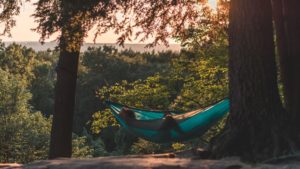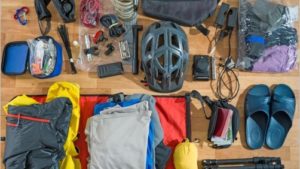The 10 Essentials list for hiking and backpacking survival could literally save your life.
In fact, it’s so important that you should print it out and refer to it every time you pack for a hiking or backpacking trip. Even better, memorize it!
The 10 essentials are common-sense items that you should always take on the trail, and they’re on the list for very important safety reasons. But it’s only a list unless you take action and follow it point by point!
We’ll explain each item in detail, so for your own safety, please read the entire list carefully. Then consider putting together a 10 essentials kit and storing it beside your backpacking equipment so you can’t possibly forget it.
- Map
- Compass (plus optional GPS)
- Sunglasses and sunscreen
- Extra food and water
- Extra clothes (including rain gear)
- Flashlight (plus optional headlamp)
- First aid kit
- Fire starter
- Matches
- Knife
Map
Getting lost in an unknown wild area can be dangerous, even if the area is a small plot of land. Even if you’re positive you know the trails blindfolded, your team should never be without a detailed topographical map that shows terrain, elevations and trails. Bringing a map will also improve the confidence your group has in their leader.
Whether or not you bring a GPS in addition to your compass, get a map with GPS markings to provide an extra level of safety and security. (In an emergency, a map with GPS grid coordinates will allow you to give “best guess” estimates of GPS locations to rescue personnel, even if you don’t have a functioning GPS unit with you.)
Compass
A map without a compass is a canoe without a paddle. You may have some general idea of where you are on the map, but choosing which direction to take can be difficult and potentially deadly. A compass is also vital for triangulating landmarks on the map, a handy method when you’re locationally confused (lost).
An optional GPS can also add to your ability to find your way, but don’t depend on a GPS completely. You still need the compass (and need to know how to use it) in case the GPS batteries run out or it malfunctions. Don’t rely on electronic solutions alone to keep you safe.
Sunglasses and Sunscreen
The sun can be one of your worst enemies during a hike if you’re not well prepared. Aside from speeding dehydration, too much direct sunlight causes sunburns and can torture unprotected eyes. Sunscreen (unscented, in bear country) should be at least 30 SPF and sweat resistant to shield your skin from the sun’s harmful rays.
Extra food and water
Extra food and water are very important for every hike, but especially for one spanning more than a single day. Lightweight, dehydrated or freeze-dried food, plus high-energy trail mix, keeps your body functioning during the stresses of the trek. Extra food will help build morale and bring calm during extended emergency situations.
Be aware, however, that on long hikes normal amounts of food will not necessarily make up for calories burned, and you run the risk of bodily shutdown due to low blood sugar. Don’t limit your chances of survival by skimping on food!
Water is a bit tricky if you’re planning a long trek. You’ll need at least four liters, and up to seven liters a day (if you’re doing any cooking), per person. Be sure that you KNOW where water sources are located and that you have planned for one or more methods of water purification.
Extra clothes
Your trip could be unpleasant if you pack only one shirt or one pair of socks. Weather is often unpredictable, and squishing around in wet socks all day is not an exciting experience. Wearing wet clothes is dangerous, plus your crew mates will be glad you’ve got a fresh-smelling shirt to wear after a few days of hiking.
Rain gear is also essential, even if the weather forecast shows clear skies. Hiking with no rain protection can send you toward hypothermia, not to mention soaking your clothes. You’ll probably want a FULL but lightweight rain suit (jacket and pants) for the most protection and as an extra layer of warmth in cold weather.
Flashlight/Headlamp
Being blind in the wild is dangerous and debilitating. Bring a flashlight and a headlamp so you can see what you’re using as a toilet and what’s inside your tent. Buy a headlamp that switches between normal beam and red beam, because red is the least “busy” color in the spectrum and bothers human eyes much less at night.
First aid kit
You should have at least one or two well-stocked first aid kits in your crew, plus each person should have a small personal kit. Injuries out in the wild that go untreated can become serious problems.
Fire starter
To help you get a fire going quickly, you should have some type of fire starter, such as fire sticks, wax candles, or homemade starters. This is especially important for emergency use, when you need to start a fire immediately for warmth or morale-building and don’t need to spend extra time gathering kindling.
Matches/Lighters
From lighting a fire to lighting a stove, lighters and matches are clearly essential. Keep your matches dry and always have a backup plan with multiple redundancies. Bic lighters are so lightweight and cheap, you should buy several and spread them around among the members of your crew. Don’t depend on one person carrying the only supplies for starting a fire.
Knife
A knife is a handy tool for cutting tape, rope, or dozens of other needs. A multi-tool can be a major improvement over a simple blade, but be sure that its weight does not outweigh its usefulness. Each person should have a knife and you should have at least one multi-tool in your crew.
Summary – The 10 Essentials List
The 10 Essentials really are essential and could save your life!
While this list covers the basic requirements for hiking and backpacking safety and survival, several supplemental items are often needed as well, which are explained in the various backpacking tips throughout this site.
Now that you know the ten essentials, please help us spread the word to other hikers, campers and backpackers…
Who created the list?
The original list of ten hiking essentials was created in the 1930’s by the famous organization, The Mountaineers, and has been used with several variations over the years by hiking and backpacking organizations and Boy Scout groups to teach hiking and backpacking safety.



